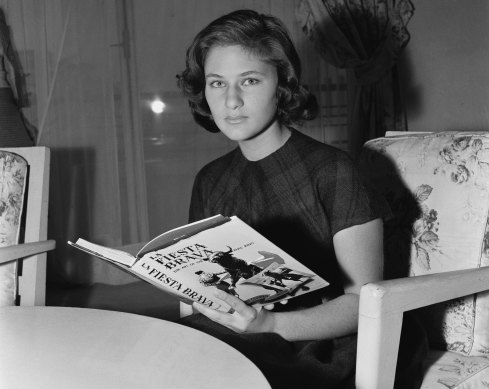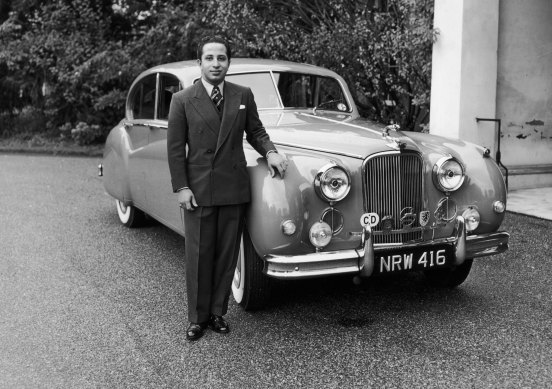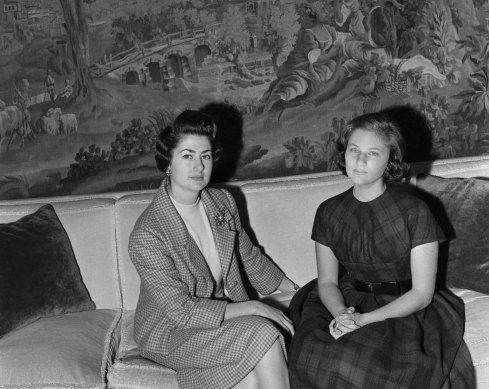This was published 4 months ago
Bride-to-be went from ‘modern Cinderella’ to forgotten princess
PRINCESS FAZILE: 1941- 2024
Princess Fazile, who has died in Istanbul aged 83, could have become a romantic young queen of Iraq in 1958, and later a doyenne of the Middle East, had fate not intervened with the brutal assassination of her 23-year-old fiance, Faisal II. For a few months in the 1950s, the world’s press took a keen interest in her, calling her a “modern Cinderella”, but then she became one of the forgotten figures of history.
The young king was well-known in Britain, having lived in Berkshire with his mother during World War II. At the age of three, he had succeeded his father, King Ghazi, when the king was killed in a car crash in 1939.
Faisal ruled under the regency of his asthmatic uncle, who remained a prominent influence in his life, as did Nuri al-Said, eight times prime minister of Iraq. He attended Sandroyd School and was later a fellow pupil with his cousin and friend, King Hussein of Jordan, at Harrow. The regency ended when he came of age in 1953, but he had yet to find a wife.

Princess Fazile, 16-year-old fiancee of King Faisal of Iraq, reading a book sent by her future husband in her apartment in Paris, 1957.Credit: Getty Images
Princess Fazile was not the young king’s first choice. The Shah of Iran, Mohammad Reza Pahlavi, wanted him to marry his eldest daughter, Princess Shahnaz Pahlavi, but she was reluctant, and instead married Ardeshir Zahedi, later an Iranian ambassador to the US and the UK. Then, in January 1957, King Faisal became engaged to Princess Kiymet Hanım, a descendant of Iraq’s Mamluk dynasty, but that engagement was broken three months later.
In September 1957, the young king was on a cruise in the Bosphorus. When he left, taking leave of President Bayar, it was revealed that there had been a more romantic and personal motive for his visit. He had become engaged to Princess Fazile, who was only 16. Unlike the earlier proposed alliances, this was a genuine love match.
Princess Nabila Sabiha Fazile was born in Neuilly-sur-Seine, near Paris, on August 8, 1941, the elder of two children of Prince Muhammad Ali Ibrahim (1900-77), a descendant of Ibrahim Pasha, Vali of Egypt (1789-1848) and a second cousin of King Farouk of Egypt.

King Faisal II of Iraq poses with a Jaguar at Stanwell Place, UK.Credit: Getty Images
Her mother, (Zeghra) Hanzade (1923-98), was the daughter of Prince Omer Faruk of Turkey and his wife, Sabiha, youngest daughter of Sultan Mehmed VI, the last sultan of Turkey, who was deposed and sailed away into exile in 1922. When the Egyptian monarchy fell in 1952, the family moved to Turkey.
Fazile – the name meant “Gracious One” – enjoyed the outdoor life, in particular sea sports and swimming. She was an accomplished pianist (loving Mozart, Bach and Chopin) and spoke French, English, Spanish, Turkish and Arabic. At 178 centimetres tall, she towered over her fiance by 13 centimetres. Alexandre, the famous French hairdresser, found her immensely shy.

Princess Fazile and her mother, Princess Hanzade, in their apartment in Paris in 1957.Credit: Getty Images
She had first met the king of Iraq at a party in Baghdad in June 1954, and when they met again in 1957, they were swiftly engaged.
Her parents were at first opposed because she was so young, but the match was formally announced at a meeting of the palace council in September 1957, headed by the king, his uncle, the crown prince, with the prime minister, Ali Jawdat, and the vice presidents of the Senate and Chamber of Deputies in attendance.
Princess Fazile was in Istanbul at the time. She held a press conference with her parents and grandmother. The prime minister of Iraq and the chief of the King’s Cabinet then arrived to present her with a letter from the king and gifts, including a ring with a large emerald surrounded by brilliants, and a brooch also made of emeralds and brilliants.
To make up for her tender age, her mother took her to Britain and enrolled her at Heathfield, the smart school for young society girls near Ascot, where Princess Alexandra had been a pupil. The Iraqi ambassador was there to meet their plane. The princess took a course for two terms, beginning in January 1958.
In September 1952, the Queen had put an aircraft of the Queen’s Flight at King Faisal’s disposal to take him and his uncle to Balmoral for a two-night stay, after which they stayed at Gleneagles. He paid a state visit to Britain in 1956. Although very young, he was a modernising and influential king, but sadly his closeness to Britain, and in particular the signing of the Baghdad Pact in 1955, led to his eventual downfall. He was dining at Downing Street the night that Nasser nationalised the Suez Canal.
His wedding to Princess Fazile was set to take place in July 1958. King Faisal, who then owned Stanwell Place (later demolished), a house set in nine hectares on Stanwell Moor, near what is now Heathrow Airport, was planning to travel to Britain for two weeks in July 1958 to visit his bride-to-be. The butler there had all the Georgian candelabra out and a five-course dinner for 12 was planned. But the night before he left Iraq, tragedy struck.
The crisis had been growing in Lebanon, and on July 13 Colonel Abd al-Karim Qasim, a military officer (who became prime minister), moved in on Baghdad and mounted a coup d’état. The next morning, King Faisal surrendered without resistance.
The king, his uncle, and other members of his family, were ordered to assemble in the courtyard of the Rihab Palace, and as the royal family left the palace through the kitchen, the king was shot in the head and neck. He died soon afterwards.
The former regent, Crown Prince Abd al-Ilah, Queen Nefissa, and other members of the royal family also died. The king’s body was hanged. Nuri al-Said was murdered the following day. The naked bodies of Nuri al-Said and the crown prince were dragged through the streets of Baghdad amid what British prime minister Anthony Eden called “scenes of unmentionable beastliness”.
The Iraqi ambassador went to Heathfield to break the news to the distraught princess, who asked the headmistress for the engagement ring she left in the school safe. She lunched privately at Coppins with Princess Marina and Princess Alexandra. Then on July 22, her parents collected her from Heathfield and took her to Paris. Thereafter, the press, who had dubbed her Cinderella, called her “the sad princess”.
It took several years for the princess to recover from this tragedy. Perhaps inevitably, in 1959 the press speculated that she might become the second wife of King Hussein of Jordan. It was said that the king filled her room in Gstaad daily with roses and asked her to marry him.
Instead, in December 1965, in Paris, she married Hayri Ürgüpli, son of Suat Ürgüpli, briefly prime minister of Turkey. They were married for 15 years and produced two sons, Ali-Suat and Selim.
They divorced in 1980, and in 1983, she married Jean-Alphonse Bernard, a diplomat, political scientist and author of Tocqueville in India. He died in 2015.
She was occasionally seen in public, bereft at the funeral of her mother in 1998, for example. Princess Fazile’s funeral was held in the Bebek Mosque in Istanbul, as was her mother’s. They are buried side by side.
The Telegraph, London
Start the day with a summary of the day’s most important and interesting stories, analysis and insights. Sign up for our Morning Edition newsletter.